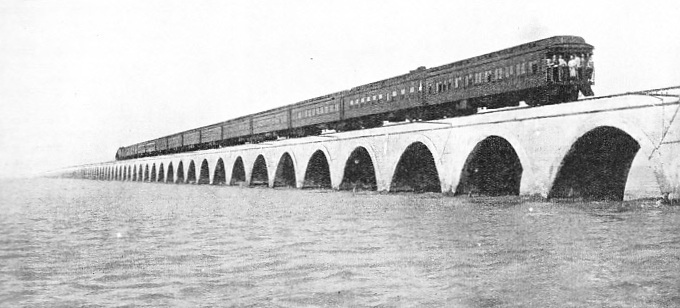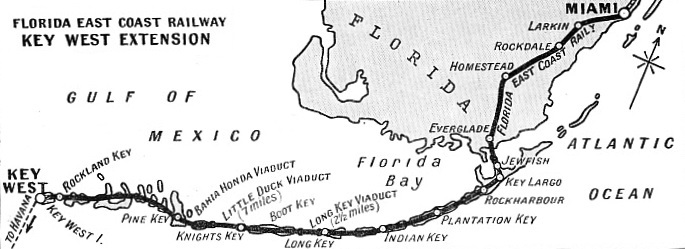When Weather Changed Railroad History: The Story of the Overseas Railroad
The Overseas Railroad spanned over 156 miles and connected mainland Florida to Key West, a chain of islands at the southernmost tip of the state in an absolute marvel of engineering. The railroad was constructed in the early 1900s by the Florida East Coast Railway (FEC) and was completed in 1912, after years of grueling labor and numerous setbacks. (Right of way)

A vintage FEC Postcard showing the Overseas Railroad at Long Key Viaduct. Palm Beach Florida Weekly
The idea for the Overseas Railroad was conceived by Henry Flagler, a businessman and entrepreneur who was instrumental in developing Florida’s tourism industry. Flagler recognized the potential of the Florida Keys as a tourist destination and saw the need for a reliable transportation system to connect the mainland to the islands.

THE HAVANA SPECIAL EXPRESS crossing the two-and-a-half miles stretch of Long Key Viaduct on the way to Key West. (Mikes Railroad History)

The FEC Key West Extension Map – This map shows how Key West is linked to Miami by the railway on a chain of islands. (Mike’s Railroad History)
Construction of the railroad began in 1905 and was one of the most ambitious engineering projects of its time. The railroad was built using a combination of dredging, filling, and bridge-building techniques, and required the construction of numerous viaducts and trestles to span the open water between the islands. The completion of the Key West extension was billed as no less than the “8th Wonder of the World” upon operations beginning in 1912.

Flagler arriving in Key West on Jan 22, 1912. (Miami-History).
We have previously discussed the plight of the Florida East Coast Railway’s extension to Key West in our blog on Railway Lines Ended by Disaster, in this blog we will discuss the FEC Key West Extension as well as the hurricane that would be its downfall barely two decades into its existence.
The construction of the Overseas Railroad was not without its challenges, however. Hurricanes were a constant threat during the construction process, and workers had to contend with high winds, heavy rain, and storm surges that could cause significant damage to the work sites. At least three hurricanes occurred during construction.

“Members of fishing party in rowboat at Bahia Honda Railroad Bridge.” Most of the bridge still stands today. (Florida Memory)
However, the railroad’s success was short-lived. On Labor Day, September 2, 1935, a Category 5 hurricane with winds of up to 200 mph struck the Florida Keys, causing widespread destruction and flooding. The hurricane, simply known as the Labor Day Hurricane since this was before hurricanes and tropical storms were named, was one of the deadliest and most destructive storms in U.S. history.

1935 Labor Day Hurricane storm track. NOAA via Wikipedia Commons.
While today, we would know many days in advance of the coming storm, these were the days before satellite imagery and constant weather observation. Thus, meteorologists could only use nearby surface stations and reports from pilots to observe “how quickly the storm was developing and how its motion was evolving.” (WUnderground)
The 1935 Labor Day Hurricane was not the first hurricane to strike the Florida Keys during the construction of the Overseas Railroad. In fact, several hurricanes had hit the region during the construction process, causing significant damage to the work sites and delaying the project. The workers had to contend with harsh weather conditions and dangerous work environments throughout the construction of the railroad.
The Labor Day Hurricane of 1935, however, was particularly devastating. It was the strongest and most intense hurricane to hit the Florida Keys up to that point, with sustained winds of up to 185 mph and a storm surge that reached 18 feet in some areas. According to the Islamorada Times, the storm reached its peak intensity of 892 mb and sustained winds of 185 mph as it made landfall on Labor Day between Miami and Key West. The exact spot of landfall was hard to determine, but it is believed to be around the Long Key area.
A rescue train swept off the tracks. (Library of Congress)
The hurricane caused widespread destruction and flooding, and many people lost their lives. In fact, the death toll from the hurricane is estimated to be over 400, with many of the victims being World War I veterans who were working on the railroad as part of a government relief program.
The Overseas Railroad was not immune to the storm’s fury. The high winds and storm surge caused significant damage to the railroad’s bridges and viaducts, and many sections of the track were washed away by the flooding. In the end, the damage was so extensive that the FEC was forced to abandon the railroad.
All was not lost, however, as the right of way was sold to the state of Florida and became an extension of US-1. This is why if you were to take a look at the Bahia Honda bridge today, you would see pavement rather than railroad ties, as the bridge was replaced in 1972 by a larger and safer bridge to the north.
Although two spans of the original bridge still stand, they are in disrepair and closed to pedestrian traffic entirely.

The Bahia Honda Bridge today. (Center for Land Use Interpretation)
The Labor Day Hurricane was a tragic end to the Overseas Railroad’s brief but illustrious history. The railroad was a remarkable feat of engineering and played an important role in the development of Florida’s tourism industry, but ultimately it could not withstand the power of nature, and thus the legacy of the Labor Day Hurricane of 1935 should remind us all of the power of nature and the fragility of human infrastructure.
The legacy of the Overseas Railroad lives on today in the form of US Highway 1, which in the Florida Keys is known as the Overseas Highway, a modern highway that follows much of the same route as the railroad and provides a vital link between mainland Florida and the Florida Keys.
Nonetheless, in addition to the bridges, much of the history of the railroad is still preserved, as parts of the original railroad can still be seen today along U.S. 1 or at museums such as Pigeon Key Historic District or Flagler Station Over-Sea Railway Historeum.
For further reading, I suggest Lee Standiford's Last Train to Paradise: Henry Flagler and the Spectacular Rise and Fall of the Railroad that Crossed an Ocean (Amazon)
Thanks as always for reading!



Comments
Post a Comment